There’s something inherently attractive and enchanting about palm trees, whether you grew up in the tropics or just love a gorgeous ornamental tree. Many of them are also fruit producers and many thrive as outdoor potted or planted trees in your garden, lawn areas, or as accent pieces or specimens. This collection of outdoor palm plants do well in any of these circumstances and one may just be the tree you’re looking for.
1. Pygmy Date Palm (Phoenix roebelenii)
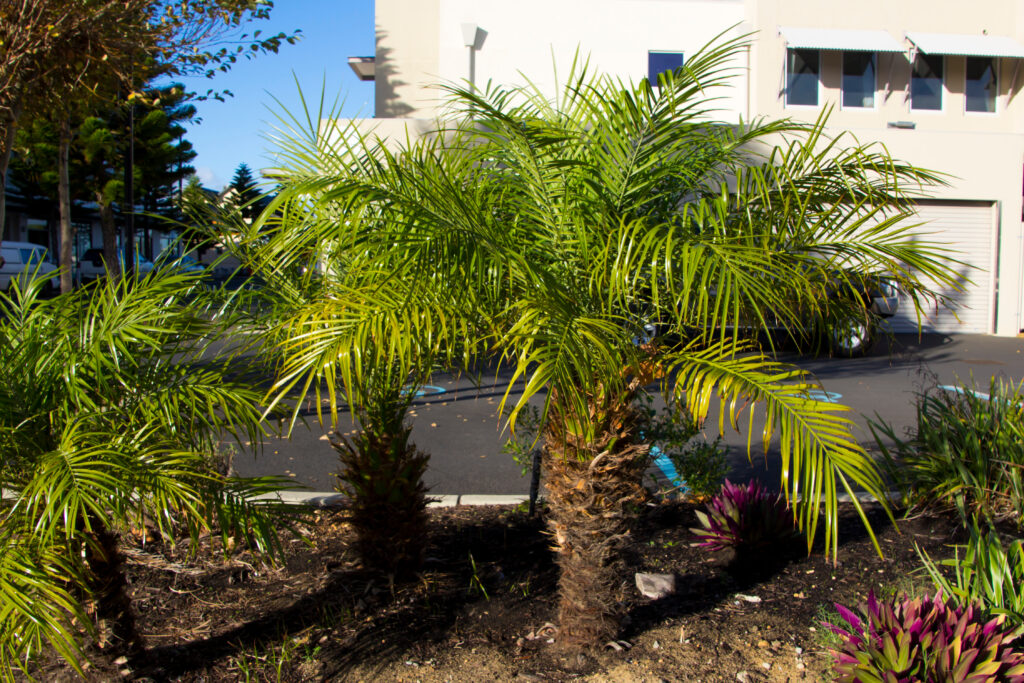
The pygmy date palm is a small, compact palm that works excellently as either an in-ground or potted palm.
©alybaba/Shutterstock.com
In case you couldn’t guess from the name, the pygmy date palm isn’t a space hog. In fact, it’s one of the more compact varieties of palm trees you can grow outdoors in containers. They are used as ornamental trees primarily, but do produce small yellow flowers that in turn produce edible fruits (female trees only). The flowers grow on foot-long stalks, then come off and the purple date-like fruit grows in. The tree has feathery fronds that grow between 3 and 4 feet in length, drooping on arching stems and creating a spiky crown of green foliage. When the tree is potted, it typically grows to no more than 6.5 feet in height, meaning you can bring it indoors in cooler months, if necessary. They do need partial sun with midday shade, so grow lights may be necessary for indoor care. Outdoors, the tree thrives in USDA Zones 10 and 11. The pygmy date palm is often used as a specimen container plant, shade palm, or driveway accent tree.
2. Christmas Palm (Adonidia merrillii)
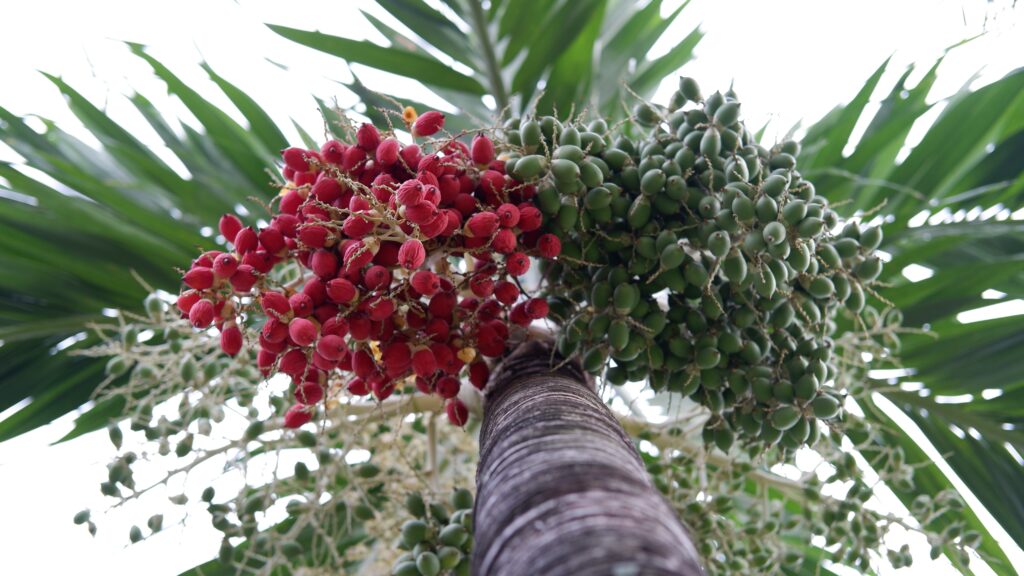
When you look at the fruits on the Christmas palm, you understand where it gets its name.
©Poetra.RH/Shutterstock.com
Christmas palms, or Adonidias, are smaller palm trees that do well as specimens or potted plants in particular. They are compact and tuck in nicely to awkward corners or narrow spots, as they don’t spread super wide like many other varieties of outdoor palm plants. They thrive most in USDA Zone 10 and in locales where the temperatures don’t drop below 32 degrees F. They’re slower growing palms, as well, meaning it will take years before they reach their full 15-foot potential, which makes them fantastic for containers. They require little maintenance, too, making them a winner for folks who don’t have a lot of gardening time on their hands. If need be, they could be brought indoors in winter, say to a cool garage or greenhouse, if they are grown in containers.
3. Mexican Blue Palm (Brahea armata)
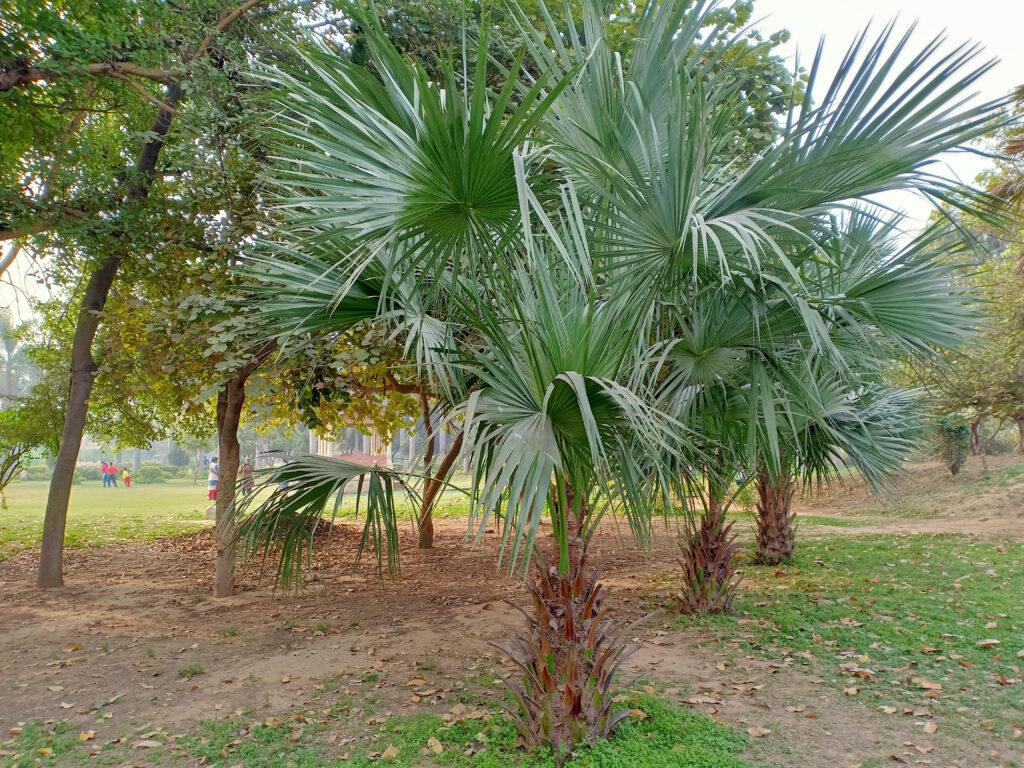
The Mexican blue palm thrives in USDA Hardiness Zones 9 to 11 in loamy or sandy soils.
©Vipul1989/Shutterstock.com
Mexican blue palms (Brahea armata), also known as blue hesper palms, are drought-resistant palm plants that tolerate fairly hot temperatures as well. They display showy silver-green fronds and spread their arms wide while eventually growing to be up to 40 feet in height. They thrive in USDA Hardiness Zones 9 to 11, in loamy or sandy soils, and can be planted in containers with proper drainage. They are less common than many other varieties, as well, so make for a unique addition to any landscaping, whether planted in the ground or grown in containers.
4. Bismarck Palm (Bismarckia nobilis)
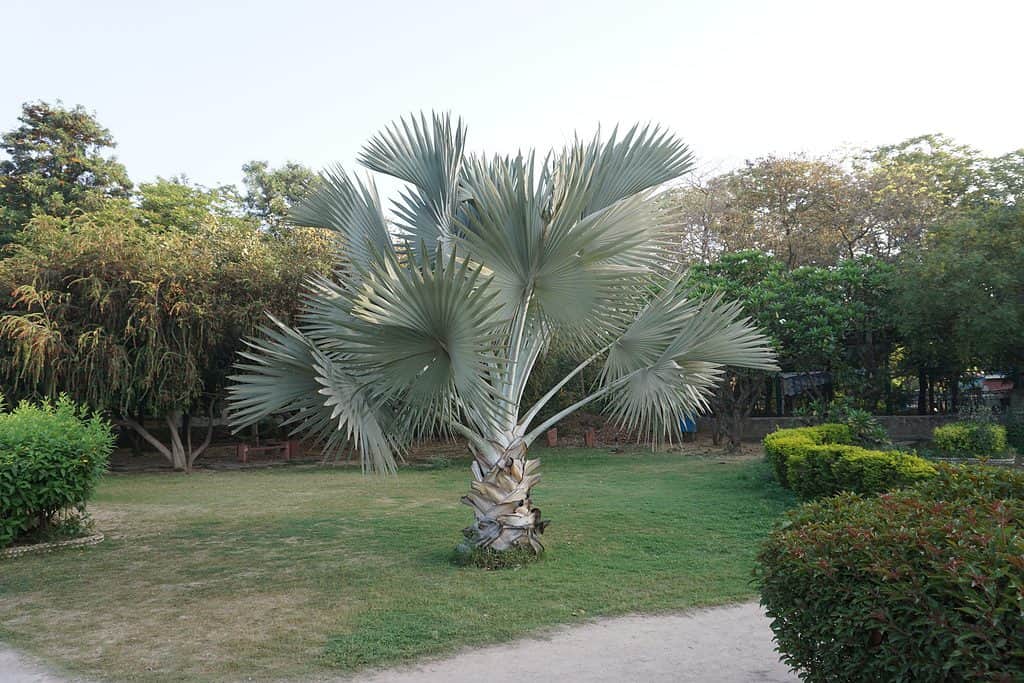
The Bismarck palm produces silver-gray fronds that are almost round and have thick trunks.
©Vipul1989/Shutterstock.com
The Bismarck palm is often grown as a container tree. They are among the tallest species that do well as container trees, reaching up to 60 feet in height when properly cared for. Their branches may span as far as 16 feet, though, so they often don’t remain container plants their whole lives. They thrive in USDA Zones 10 to 11 and though they are somewhat cold hardy, they must be covered or brought indoors in temperatures cooler than about 25 degrees F. They need full sun and well-draining soil. The tree produces silver-gray fronds that are almost round and have thick trunks.
5. Lady Palm (Rhapis excelsa)
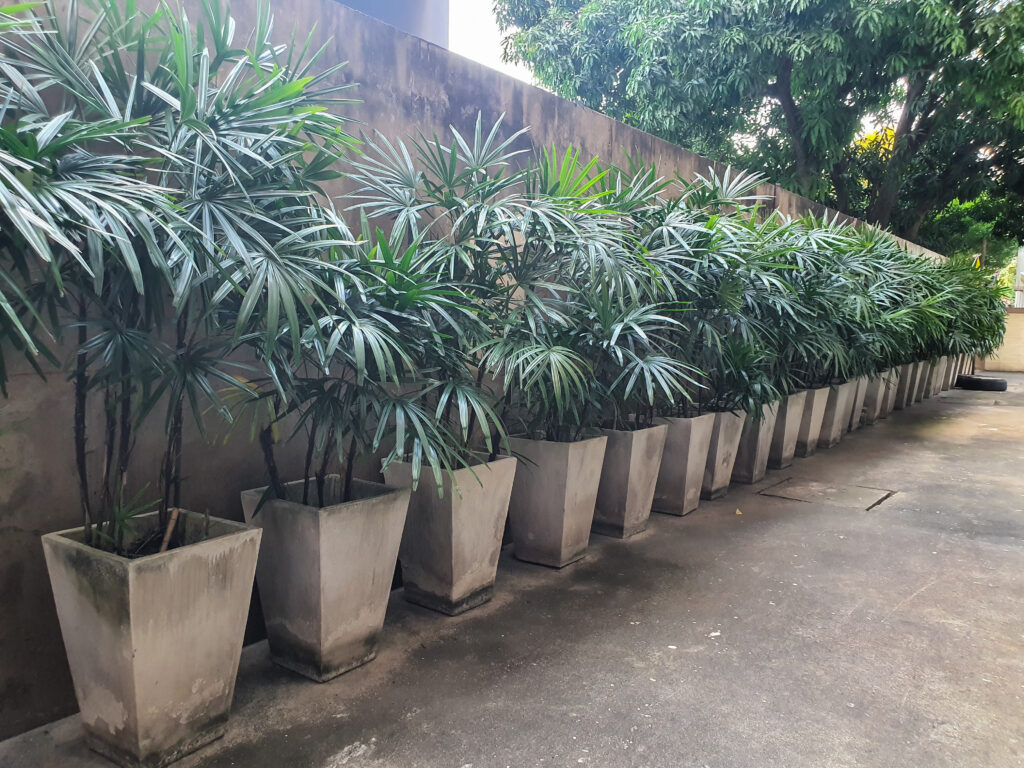
Lady palms make excellent plants for a courtyard, atrium, patio, porch, or deck.
©Maminami/Shutterstock.com
A multi-trunk tree, the lady palm (Rhapis excelsa) is similar to the bamboo palm, with glossy green leaves that are fan-shaped and stems that somewhat resemble bamboo. These palms do great as either in-ground or container trees hitting heights of 13 feet. They grow in clumps, though, so they require large containers when that’s the choice. They are, however, slow-growing so they don’t require the largest container size for quite some time. These make for excellent courtyard and atrium palms, admittedly, but are exceptional for patios, porches, and decks, as well, as container palms. They thrive in USDA Grow Zones 9 to 11 and tolerate both partial and full shade.
6. Areca Palm (Dypsis lutescens)
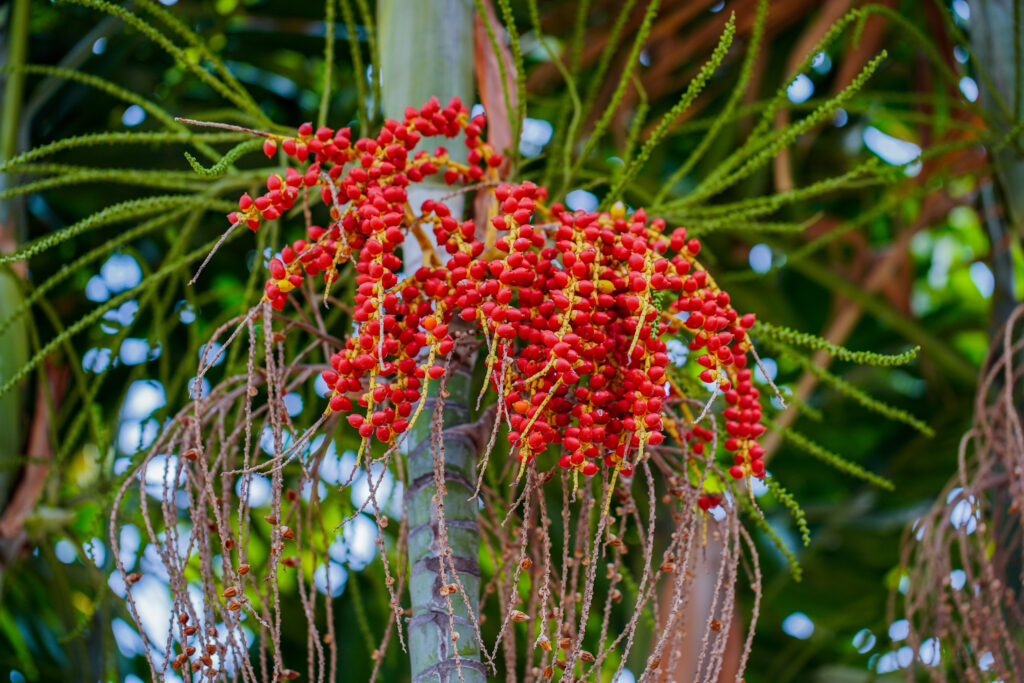
The areca palm is also known as the golden cane palm, yellow palm, and butterfly palm.
©iStock.com/chaikom
Areca palms, or cat palms, are some of the most popular container palms, thanks to their gorgeous arching green fronds and smooth green trunks. They grow in clumps and often are potted in clay or terracotta pots. They’re the kind of tree that’s limited by the pot size, but ultimately, when cared for and potted properly, they can reach upward of 21 feet tall. The tree is also known as the golden cane palm, the yellow palm, and the butterfly palm. They’re shrubby and do well in shade, full sun, or partial shade, as long as they have plenty of water. They thrive in USDA Grow Zones 10 and 11.
7. Chinese Fan Palm (Livistona chinensis)

The Chinese fan palm is an attractive accent, specimen, or privacy “screen” palm.
©Vipul1989/Shutterstock.com
Fountain palms, or Chinese fan palms, are the kinds of palms that do well in compacted soil, drought, and cold. They make excellent choices for beginning palm growers because of their hardiness and durability in multiple unfavorable conditions. When mature, Chinese fan palms reach up to 40 feet in height, with a 12 foot spread. They do well as in-ground or potted palms and thrive in USDA Zones 9 to 11 and they do best in somewhat acidic soil.
8. Ponytail Palm (Beaucarnea recurvata)
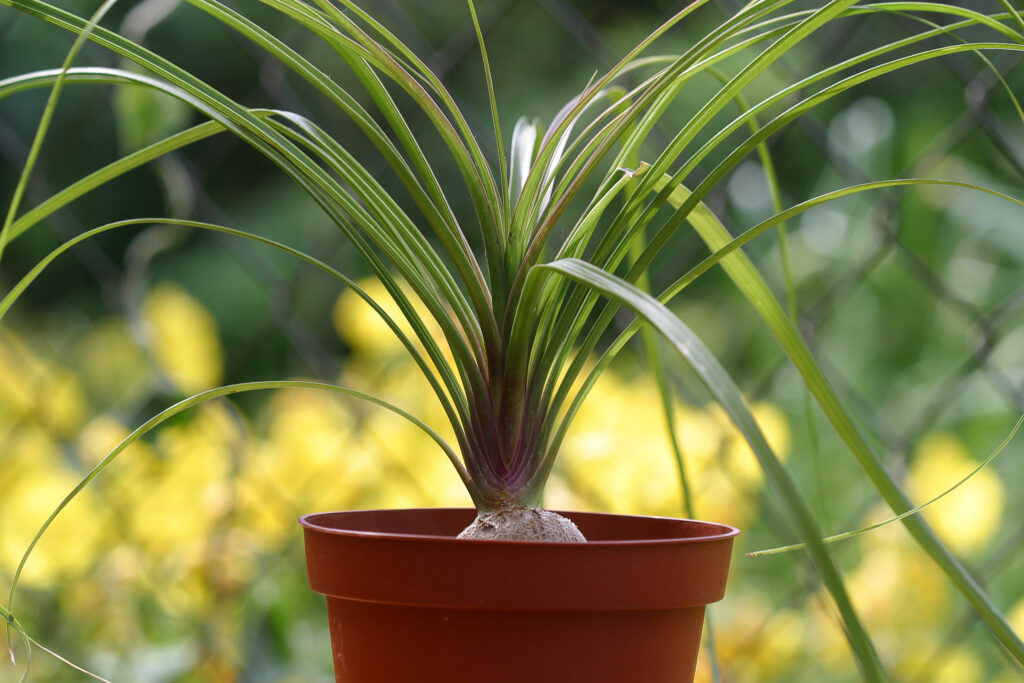
The ponytail palm stores excess water at its base and is exceptionally drought resistant.
©iStock.com/Olena Troshchak
This palm gets its name from its looks, as it looks a bit like a ponytail springing from the top of someone’s head. The plant is also known as the bottle palm and the elephant’s foot palm. The last nickname is because of the swollen appearance of the trunk base, which looks a bit like an elephant’s foot. This particular palm stores excess water at its base, giving it that swollen appearance, which means its exceptionally drought resistant. The ponytail palm is an evergreen palm tree that thrives in containers outdoors in USDA Grow Zones 8 to 12. The tree will reach 6 feet tall in a container and requires full sun.
9. Kentia Palm (Howea forsteriana)
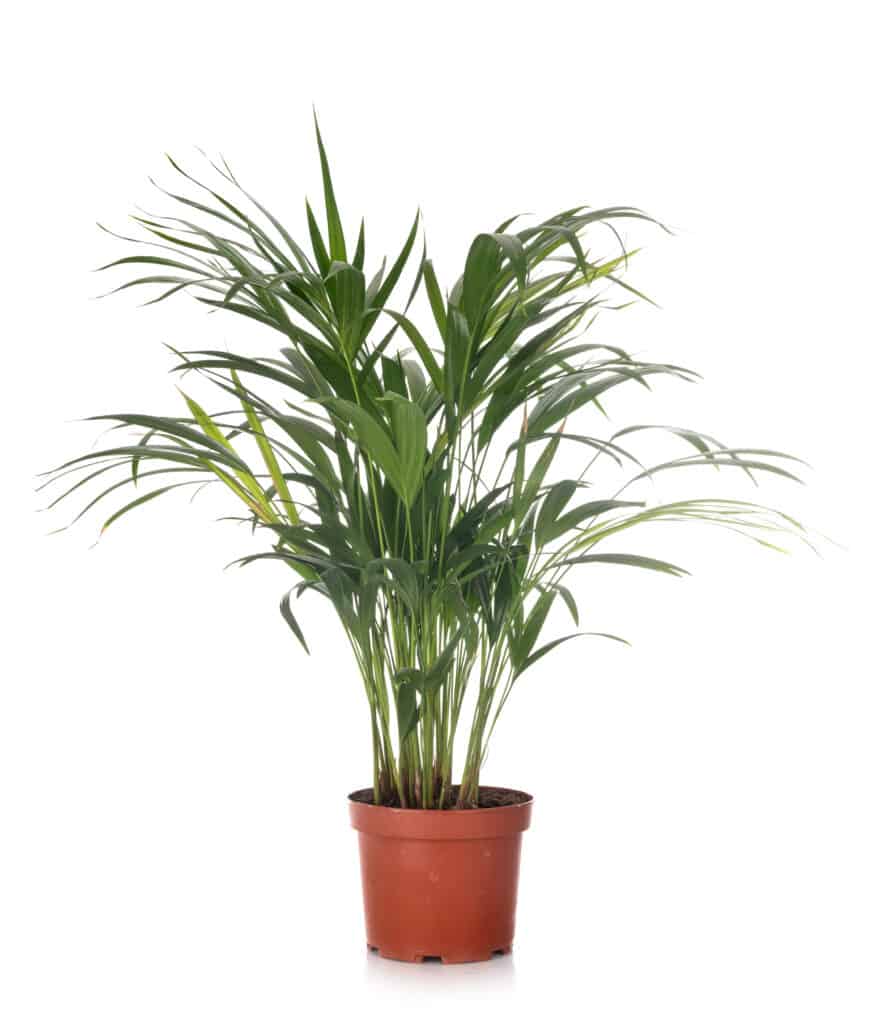
The Kentia palm can be 40 feet when planted in-ground, but is much smaller when in a container.
©cynoclub/Shutterstock.com
A hardy and easy to care for palm tree, the Kentia palm is an excellent choice for beginners. The palm is an upright, elegant tree that has a single trunk or stem, with dark green feathery leaves that reach as long as 7 feet. The tree itself may reach heights of 40 feet when planted in ground and will be much smaller when planted in a container. They thrive in shade and are cold hardy outdoors in USDA Zones 9b to 11.
10. Silver Saw Palmetto (Serenoa repens)
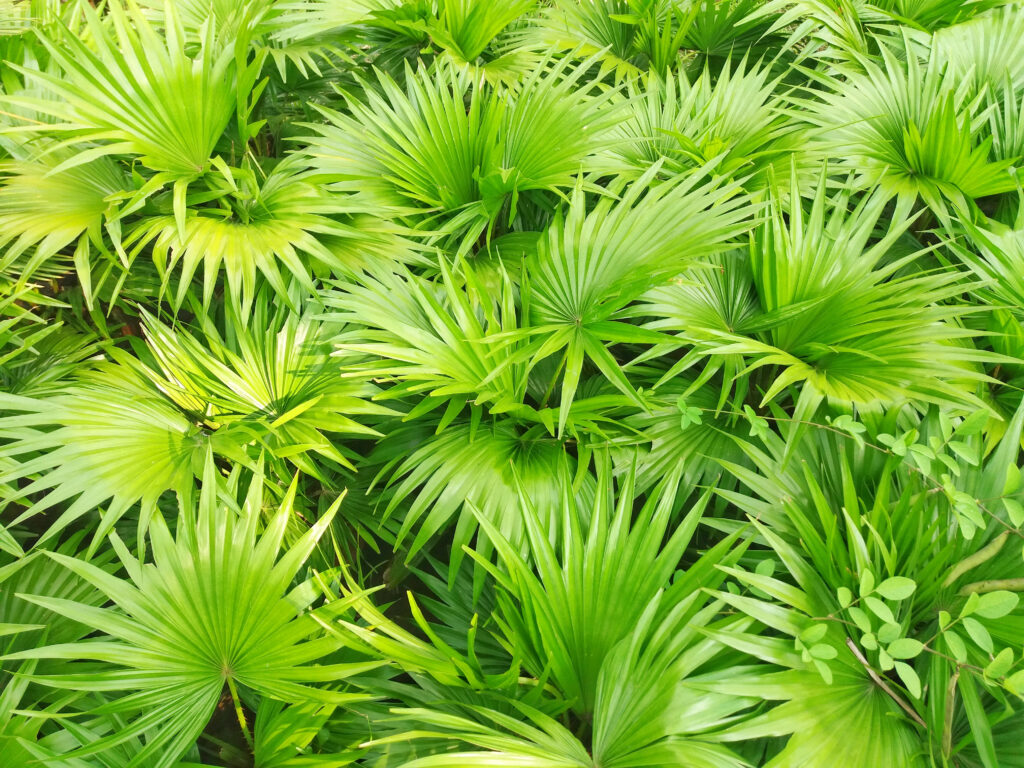
The silver saw palmetto may grow in brighter green to silver-gray.
©skjahirul007/Shutterstock.com
The Florida native silver saw palmetto is a beautiful, smaller palm choice for cooler climates. They are suitable for USDA Grow Zones 8 to 11 and may grow wider than they are tall. This makes them great for edging and privacy screen palms but not quite as great for potted, though they can be kept in containers, as long as there is space around the containers for the frond growth. They often reach 30 feet in height, though more frequently as potted plants only 8 to 10 feet in height. They often as are wide as 20 feet, though, so they need plenty of space wherever they are planted. The palms are cold, salt, and deer resistant, and partially drought resistant, though you don’t want to let them get dry and stay that way.
11. Jelly Palm (Butia capitata)
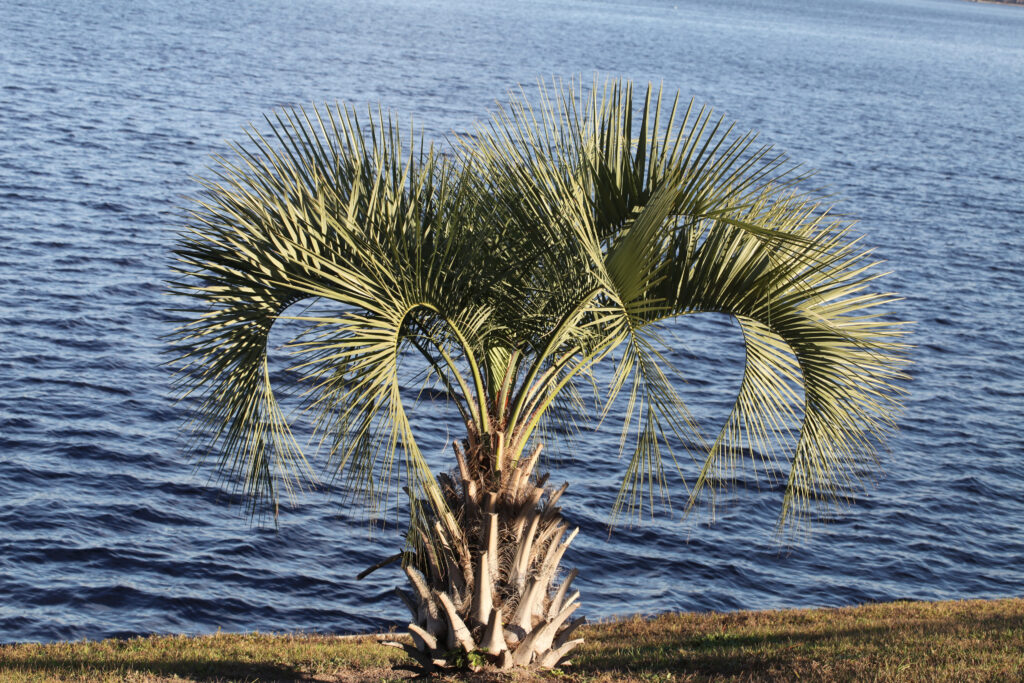
A lone pindo palm tree growing near the sea.
©iStock.com/viktor2013
Known as pindo or yatay palms, the Butia capitata tree is a structured beauty favored as a potted or in-ground palm outdoors. These jelly palms are fairly cold resistant and handle harsh coastal environments, higher temperatures, and even drought. They are suited to USDA Grow Zones 8b to 11 and can survive down to 14 degrees F, though it’s not advised to let them do this often or without cover, and actually thrive in containers. They may hit up to 20 feet in height, with a spread of 20 feet once they reach maturity. They need plenty of sunlight and well-draining soil.
12. Sentry Palm (Howea belmoreana)
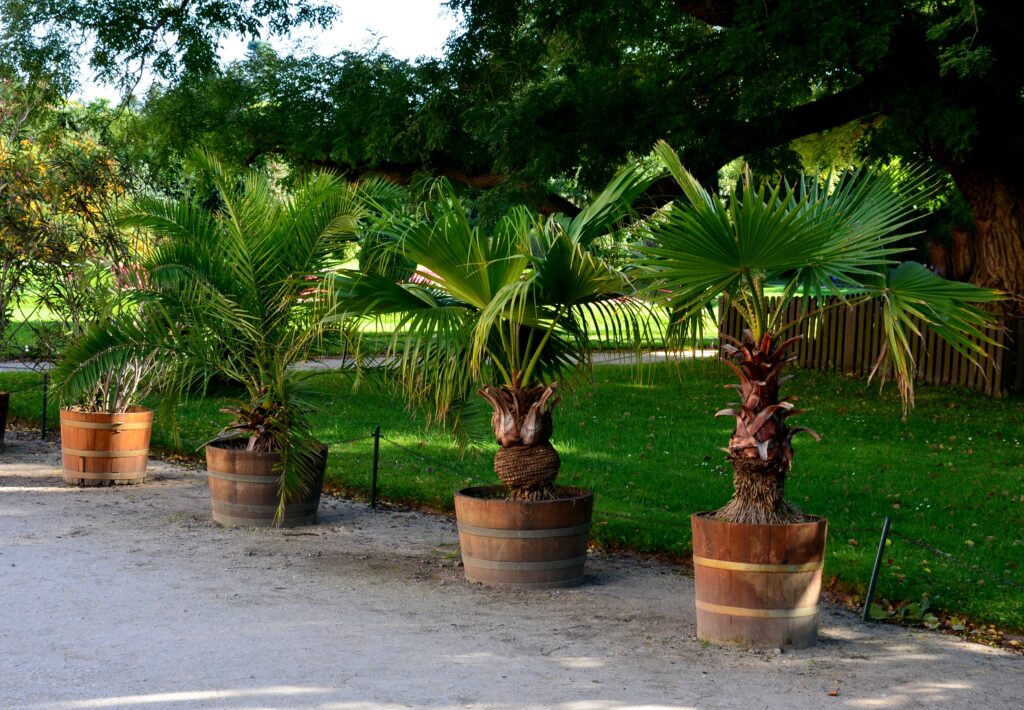
The beautiful sentry palm is often used as potted specimens like these, keeping “watch” along the pathway.
©Beekeepx/Shutterstock.com
Sentry palms are a specific variety of palm that do well as small palms because they still thrive when restricted by pot size. They have slender, ringed stems, massive arching fronds with a rounded crown, and tend to grow upright rather than drooping. They may hit heights of 33 feet when left to grow widely, but as a potted palm they will be slower growing and not as tall. They thrive outdoors in USDA Zones 9b through 11.
13. Parlor Palm (Chamaedorea elegans)
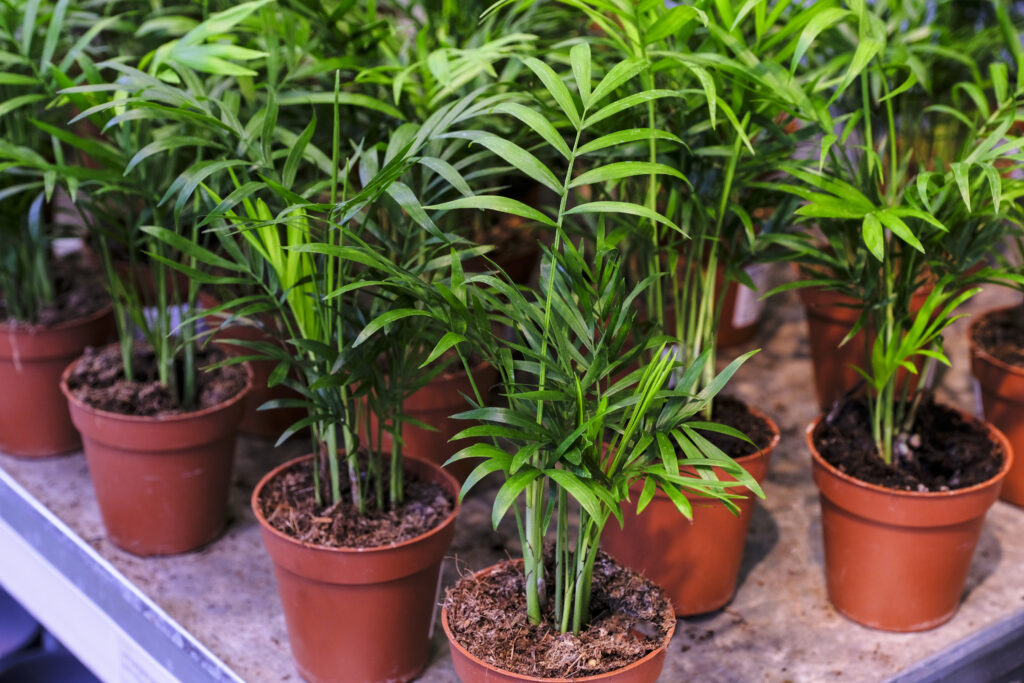
Parlor palms typically develop multiple, slender green trunks, with pinnate green leaves.
©iStock.com/Olga Ostapenko
The beautiful parlor palm gets its name from its popularity as an indoor palm tree. However, the tree thrives outdoors as a potted palm in warmer climates, as well, and tends to be a slow-grower, making it easier to manage. They typically develop multiple, slender green trunks, with pinnate green leaves. They produce small orange, red, or yellow blossoms and reach up to 6.5 feet tall with a their fronds up to 8 inches long. They do well in USDA Zones 10 to 12 and thrive in dappled sun or deep shade.
14. Lipstick Palm (Cyrtostachys renda)

The beautiful lipstick palm has a distinctive red trunk and green stems.
©Michaelnero/Shutterstock.com
Lipstick palms are a smaller variety of palm tree that have distinctive red trunks, earning them their nickname. Lipstick palms are truly an effortless potted palm (compared to some other varieties) and thrive in USDA Zones 10 and 11. Technically, they can thrive in other zones, as well, as long as temperatures don’t hit below 40 degrees F. They can reach up to 50 feet in height, when conditions are just right, but more commonly they peak at 30 feet.
15. Dwarf European Fan Palm (Chamaerops humilis)
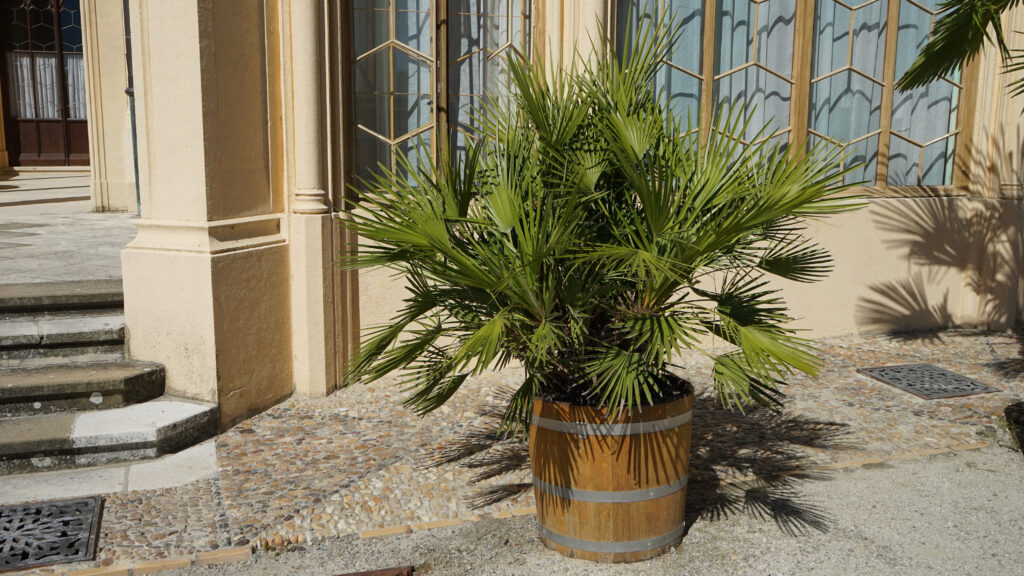
The dwarf European fan palm is an excellent potted palm.
©Dusan UHRIN/Shutterstock.com
The dwarf European fan palm is another smaller palm that it exceptionally suitable to gardens as either in-ground or potted trees. The tree is shrub-like, loves the heat, needs plenty of direct sunlight, and grows on multiple trunks with a shaggy look. The silver-green fan-shaped fronds will grow to 5 feet in length, but they’re a slow growing tree so they’re manageable. They thrive in USDA Zones 8 to 11 and tend to be cold hardy, wind tolerant, and drought resistant.
16. Bamboo Palm (Chamaedorea seifrizii)
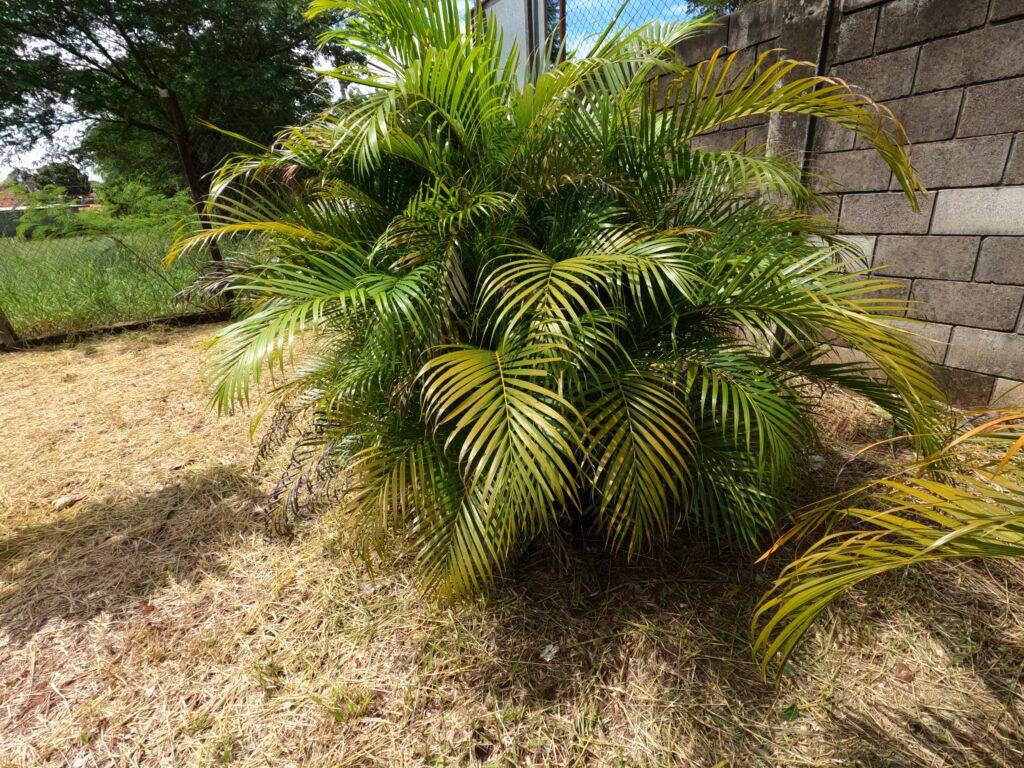
The bamboo palm is often used as a hedge plant, thanks to its spreading nature.
©Bruno H.P/Shutterstock.com
Thriving in USDA Grow Zones 10 to 12, the bamboo palm is technically a subtropical plant that also goes by the name of reed palm or parlor plant (not to be confused with parlor palm). The tree grows slender-bamboo cane-like trunks that are upright, with clusters of dense, dark green frons. The tree may be up to 7 feet tall, when cared for properly, and does well either in-ground or in containers. In containers, the palm gains a compact appearance, however. The palm is often used as a hedge plant, thanks to its spreading nature, but also works well as an accent plant or specimen.
17. Majestic Palm (Ravenea rivularis)
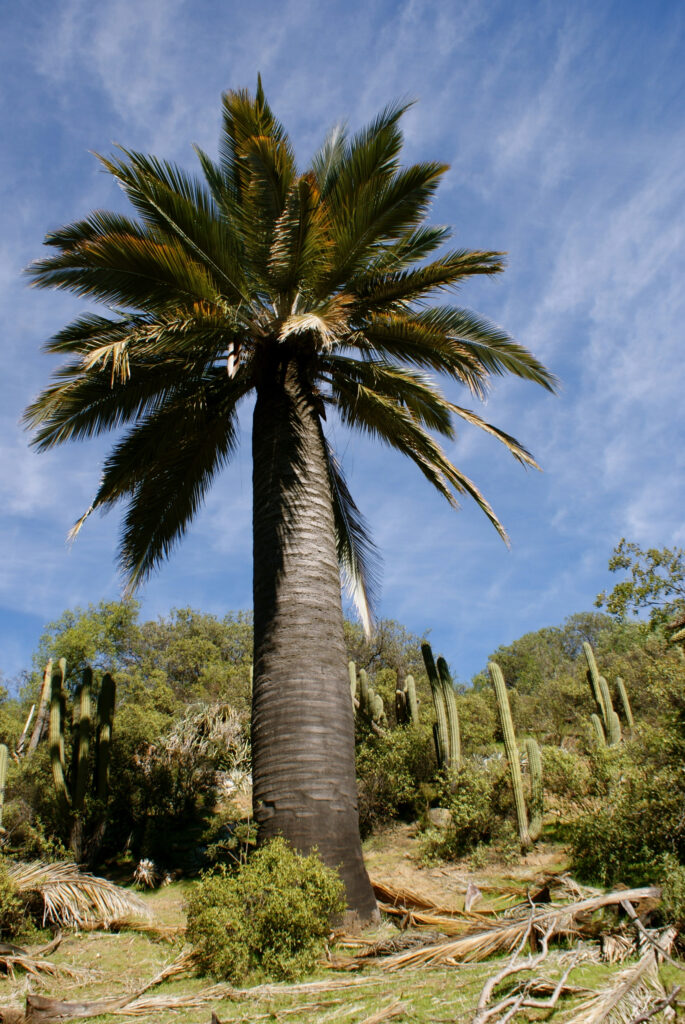
The majestic palm lives up to its name! The giant tree is both majestic and gorgeous.
©JavieraSM/Shutterstock.com
One of the varieties of palms that requires humidity, the majestic palm is a popular choice among folks in humid regions like in-land Florida, but it does not do well on the coasts (not salt-tolerant). The tree is slow-growing, making it manageable as a tall outdoor container palm. It’s often used as a privacy tree or specimen tree. When grown in containers, the fronts grow as long as 8 feet and the tree will grow up to 20 feet in height. The trees are fairly easy to grow and endure multiple conditions, including damp, swampy conditions. The majestic palm thrives in USDA Grow Zones 9 to 12.
18. Chestnut Dioon (Dioon edule)
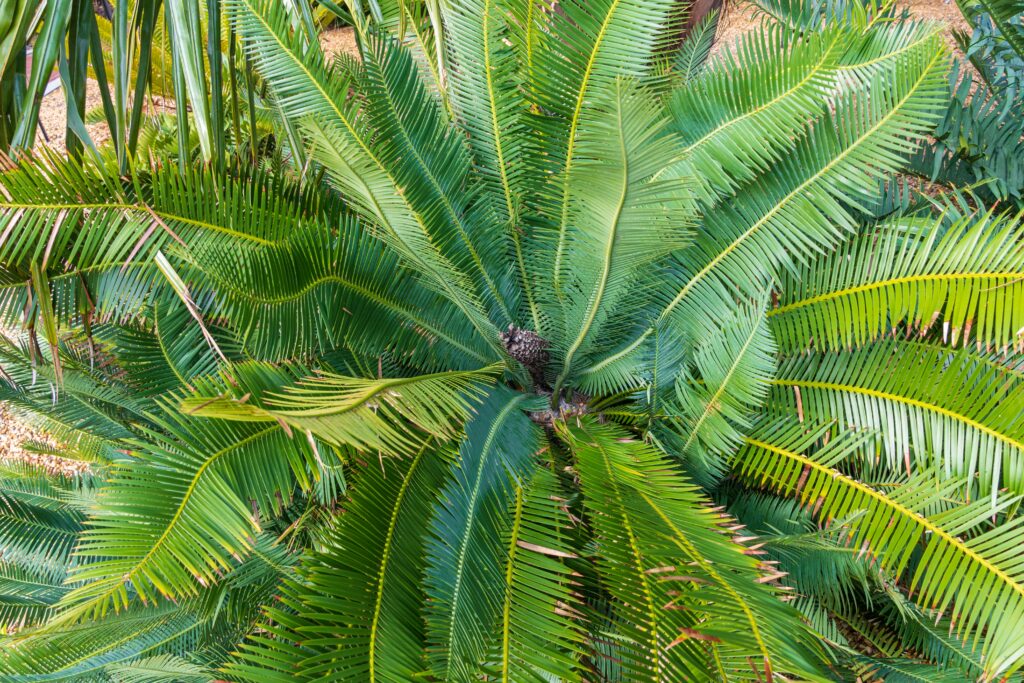
The unique chestnut dioon palm does look like a palm, even if technically a cycad.
©Sunshower Shots/Shutterstock.com
Technically not actually a palm, but darn close as a cycad (the Sago Palm is another cycad), the chestnut dioon grows natively in Mexico where it is known as the Palma de la virgen (Palm of the virgin). The faux palm is a slow grower and looks like a true palm, and because of its size of only 8 feet at maturity, it makes for an excellent container palm outdoors. They thrive in USDA Grow Zones 9 to 11.
19. Fishtail Palm (Caryota mitis)
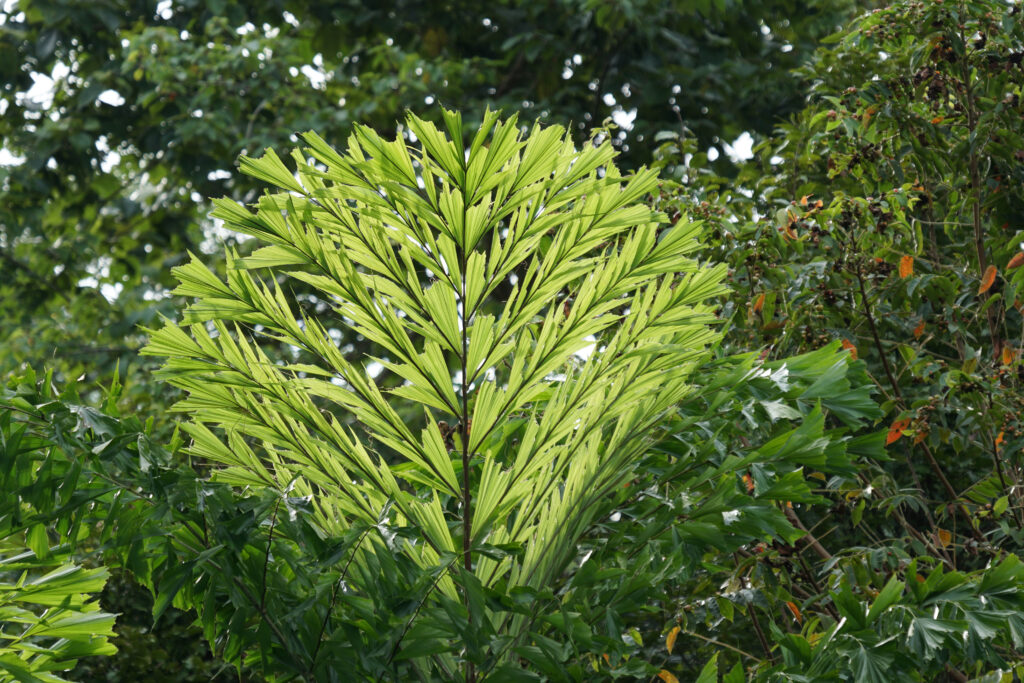
The unique fishtail palm does, indeed, resemble a fishtail, as does each leaf.
©Doikanoy/Shutterstock.com
Fishtail palms earn their name from their unique leaves that look a bit like jagged fishtails. They are ornamental and grow in clumps of multiple slender stems with masses of feathery fronds. The leaves are yellow-green and may grow as long as 10 feet. They thrive in USDA Grow Zones 9b to 11 and are often chosen as container palms, specimen palms, privacy screens for pool areas and backyards, and corner accents.
Summary of 19 Palm Plants That Grow Outdoors
Here’s a recap of the 19 palm types that we took a look at that are suitable for growing outdoors.
| Number | Palm | Scientific Name | Maximum Height | USDA Grow Zones |
|---|---|---|---|---|
| 1 | Pygmy Date Palm | Phoenix roebelenii | 6.5 feet | 10-11 |
| 2 | Christmas Palm | Adonidia merrillii | 15 feet | 10 |
| 3 | Mexican Blue Palm | Brahea armata | 40 feet | 9-11 |
| 4 | Bismarck Palm | Bismarckia nobilis | 60 feet | 10-11 |
| 5 | Lady Palm | Rhapis excelsa | 13 feet | 9-11 |
| 6 | Areca Palm | Dypsis lutescens | 21 feet | 10-11 |
| 7 | Chinese Fan Palm | Livistona chinensis | 40 feet | 9-11 |
| 8 | Ponytail Palm | Beaucarnea recurvata | 6 feet | 8-12 |
| 9 | Kentia Palm | Howea forsteriana | 40 feet | 9b-11 |
| 10 | Silver Saw Palmetto | Serenoa repens | 30 feet | 8-11 |
| 11 | Jelly Palm | Butia capitata | 20 feet | 8b-11 |
| 12 | Sentry Palm | Howea belmoreana | 33 feet | 9b-11 |
| 13 | Parlor Palm | Chamaedorea elegans | 6.5 feet | 10-12 |
| 14 | Lipstick Palm | Cyrtostachys renda | 50 feet | 10-11 |
| 15 | Dwarf European Fan Palm | Chamaerops humilis | 5 feet | 8-11 |
| 16 | Bamboo Palm | Chamaedorea seifrizii | 7 feet | 10-12 |
| 17 | Majestic Palm | Ravenea rivularis | 20 feet | 9-12 |
| 18 | Chestnut Dioon | Dioon edule | 8 feet | 9-11 |
| 19 | Fishtail Palm | Caryota mitis | 10 feet | 9b-11 |
The photo featured at the top of this post is © Sunshower Shots/Shutterstock.com
Thank you for reading! Have some feedback for us? Contact the AZ Animals editorial team.






